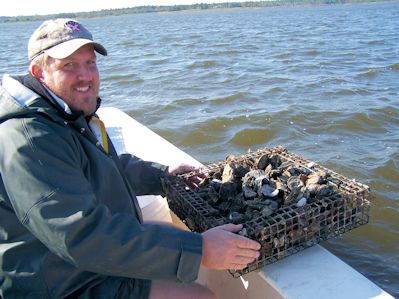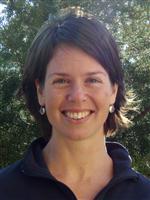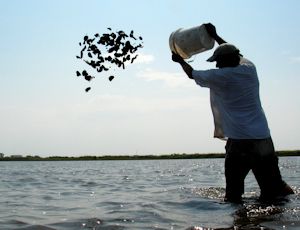BEAUFORT — Organizers of the March 12-13 oyster workshop at the NOAA Beaufort lab on Pivers Island say it was a successful event that re-energized participants and will lead to more effective and efficient efforts to enhance North Carolina’s oyster fishery and the crucial habitat that supports it.
“We all got a chance to compare notes and to see what has worked and to make sure we’re all on the same page as we move forward,” said Ted Wilgis, a coastal education coordinator for the N.C. Coastal Federation, one of the organizers of the conference. “We were very pleased with the presentations and discussions. It was a jam-packed agenda, and we had great participation from state and federal researchers, policy people, representatives of the fishery, resource managers and others.
Supporter Spotlight

Ted Wilgis hopes collaboration will provide more opportunities for programs like this one, which monitors the health of oyster reefs. |
“Everyone worked hard,” added Wilgis, who is based in the federation’s Wrightsville Beach office. “We asked a lot of those who participated; it was very intense and fast-moving, an effort to do a lot in a short time. I think everyone learned a lot and came away feeling good about efforts in the future.” Twenty years ago, North Carolina’s oyster population and its commercial harvest were in an abyss, decimated by pollution, loss of habitat and decades of infestation by dermo, a parasitic disease that kills the shellfish before they reach the legal harvest limit.
The state’s watermen in 1994 harvested a paltry 34,727 bushels of oysters, worth a meager $632,000, according to state Division of Marine Fisheries figures.
As oyster and fish houses continued to shut down and fisheries managers contemplated drastic measures, such as bringing in and planting non-native oysters in the state’s coastal waters, an industry that once supported thousands of fishermen and their families seemed headed for a technical knockout.
But thanks to concerted efforts by many – including state agencies, NOAA, nonprofit groups like the N.C. Coastal Federation and academic researchers – the oyster fishery has staggered back to its feet, with harvest reaching 196,661 bushels in 2010 and 151,314 in 2011 before dropping to 83,188 in 2012.
Supporter Spotlight
Experts, such as Craig Hardy, the lead oyster biologist at the fisheries division and a participant in the workshop, don’t believe there’s a new downward trend under way; Hardy said environmental factors were largely responsible for the 2012 dip.
Poster and oral presentations over the two-day meeting encouraged discussions and group consensus-building, and participants produced a set of workshop findings that will help determine future action items, strategies, resources and partnerships.

Erin Fleckenstein |
Although recommendations have not yet been put in writing and finalized, the idea is to use what was learned at the workshop to build toward revising and updating the existing Oyster Restoration and Protection Plan for N.C.: A Blueprint for Action. At an anticipated January 2015 N.C. Oyster Summit, workshop findings will be reviewed, and then, incorporated into a third edition of the Restoration and Protection Plan that will guide state research and restoration efforts from 2015 to 2020.
Wilgis said a key decision at the workshop was to organize two work groups, one for the northern segment of the state’s coast, which has vast expanses of sub-tidal oyster and shellfish waters, such as Pamlico Sound, and one for the southern segment, which generally is home to more intertidal small rivers and sounds that over the years have seen more development and more effects from stormwater runoff and pollution. The dividing line will be the White Oak River, between Onslow, Jones and Carteret counties.
One big idea, Wilgis said, is to use what was learned about what has worked to come up with a list of “shovel-ready” habitat restoration and creation projects for which grant money can be sought. And, he and Erin Fleckenstein, a federation scientist, said last week that the collaboration and networking during the workshop should enable those with an interest and a stake in oyster habitat and harvesting to better seek those grants without duplicating efforts.
There also was agreement, Wilgis said, among those involved in efforts to identify more sources of shells for the projects; one big idea is to create a sanctuary, working with the state fisheries division, in the Cape Fear River.
Brian DeAngeli offered encouragement to those at the workshop, Wilgis said. DeAngelis is a Nature Conservancy program coordinator and fisheries biologist and the former research assistant at the National Marine Fisheries Service. He said North Carolina is “lucky” to have had good support from the state, especially the fisheries division, and a variety of partners in the effort, enabling work to proceed on not just one front, but many, including fisheries enhancement and water quality.
The latter is a key to the involvement of the federation, which got involved in a big way more than a decade ago because of its mission of protecting and enhancing coastal water quality. Because shellfish filter pollutants as they feed, a healthy oyster stock is essential to water quality.
Oysters can live up to 40 years and grow up to 8 inches; however, most N.C. oysters are harvested at three years of age, at the minimum harvest size of three inches. In the early stages of an oyster’s life, it’s carried about by currents. As it matures, the oyster sinks to the bottom, and to survive, it must land on a hard surface. That’s why they are found growing together in clumps.
Experts say each adult oyster filters and cleans up to 50 gallons of water a day, eating algae and removing sediments and nitrogen, so it’s easy to see why a good oyster population makes a big difference in water quality.
Wilgis said another important “take home” from the workshop was the importance of making sure projects are monitored carefully and evaluated in similar ways. There are, of course, some who look at efforts specifically in terms of water quality improvements, but others look more for fisheries enhancement. Some projects obviously do more for one than for the other, but researchers need to be able to communicate with each other and present results and recommendations in ways that all involved can understand.
“We need to be sure that we’re generally using the same metrics” to determine successes and failures, Wilgis said, so all involved can learn from each other.
Another important decision was to develop a common web site on which researchers and project managers can share information not just with each other, but with the public. Ideally, he said, those involved could upload reports on what they’ve learned and post links to other relevant studies they have found and perhaps used.

Successful restoration projects depend on the cooperation of organizations, state agencies and volunteers like this guy who’s building an oyster reef one bucket at a time.
|
One of the few problems at the workshop, Wilgis said, was a lack of time. The various presentations were lightning-fast, he said, so there will need to be more in-depth discussions. Another issue, he said, was a lack of emphasis on oyster farming and the important role it can play in habitat enhancement, water quality and harvesting.
Hardy, the state fisheries division’s “go-to” guy for most things oyster-related, was similarly pleased with the workshop.
“There was a lot of information presented in a pretty short amount of time, but it was presented very well and well-organized,” he said. “Not only that, it was a good opportunity for people to just get to know each other a little better and learn more about where everyone is heading.
“I think it was a very good first step” toward the summit next year, Hardy said, a way to make sure everyone is focused and working together toward the goal of coming up with practical and effective strategies and projects that can be adopted in the next five-year plan to preserve and enhance habitat and fisheries.
Like Wilgis, he noted that the format did not lend itself to in-depth discussions, because there were so many topics and so much to do in a relatively short amount of time. But he said there are plans for participants to get together before the summit to talk more in-depth on topics.
All-in-all, Hardy said, the workshop was a “huge success.” He said he felt “re-invigorated” and believes he and others came away more optimistic that — in an era in which it’s harder to find state and federal budget allocations and grants for oyster work — there is a strong desire among capable people to continue to make headway in an effort most people believe is very important.
Fleckenstein, who is based in the federation’s office in Manteo, agreed that the workshop was great opportunity – and a successful effort – to get almost everyone involved in the same place and on the same page.
“I think the general feeling was that we all are impressed by what has been done and by the information that we have and can use as we move ahead,” Fleckenstein said. “But I think we all also agreed that despite all the work that has been done, there is a lot left to do. The good news is that I believe we’re all strongly motivated to keep going.”
And motivation, Fleckenstein said, is important, in part because of state and federal budget cuts, which make it harder to find money for good projects. It’s also important because it’s easy to indulge a natural tendency to rest after achieving some success.
“I think a lot of ideas were generated,” she said. “It’s important for everyone to get together periodically, and we were fortunate to have a wide variety of people involved in the workshop. And people worked well together.”
Along with the federation, other sponsors were the Albemarle-Pamlico National Estuary Partnership, the N.C. Division of Marine Fisheries, the N.C. National Estuarine Research Reserve, the N.C. Sea Grant College Program, the N.C. State University Center for Marine Science and Technology, the UNC-Chapel Hill Institute of Marine Sciences and the UNC-Wilmington Center for Marine Science.








